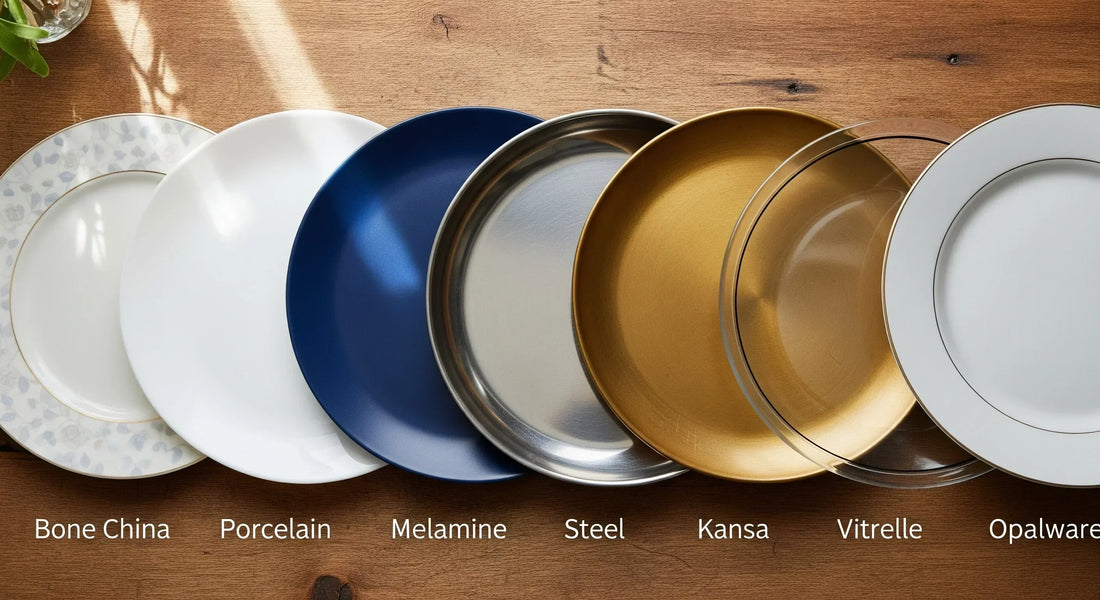
7 Materials You Didn't Know Tableware Was Made Of !
Choosing the Right Tableware: A Luxe Guide
From timeless bone china to modern opalware, each tableware material has its own character, durability, and charm. While bone china and porcelain are elegant and versatile, melamine offers affordability and break resistance but comes with important health considerations. Traditional kansa brings heritage and warmth, while vitrelle and opalware provide modern, lightweight convenience.
Missera’s Pick: For daily use, we prefer premium porcelain tableware over melamine — it’s microwave-safe and completely free from microplastics. Indian meals are meant to be enjoyed hot, and with Missera’s imported Japanese luxe porcelain tableware, you can reheat your food without worry and savor it stress-free. Melamine, on the other hand, can release microplastics when used with hot meals. When it comes to your health, your dining ritual, and your table’s visual appeal — premium porcelain is the clear winner.
| Feature | Bone China | Porcelain | Melamine | Steel | Kansa (Bronze) | Vitrelle | Opalware |
|---|---|---|---|---|---|---|---|
| Material | Bone ash, kaolin, feldspar, quartz | Kaolin, feldspar, quartz | Melamine resin (synthetic plastic) | Iron, carbon, and alloyed metals (e.g., stainless steel) | Copper, tin, occasionally zinc | Tempered glass, laminated with glass layers | Glass with opal or ceramic coating |
| Durability | Very strong, chip-resistant | Strong, can chip if mishandled | Extremely durable, break-resistant | Extremely durable, rust-resistant | Durable, but soft, tarnishes with age | Highly durable, resistant to breaking | Strong, durable, resistant to chipping |
| Weight | Lightweight, delicate | Medium to heavy | Very lightweight | Lighter than bone china or porcelain | Heavy, solid feel | Lightweight | Lightweight |
| Appearance | Translucent, creamy, elegant | Smooth, glossy, often white or translucent | Matte or glossy, plastic-like appearance | Sleek, modern, shiny or matte | Reddish-golden, develops patina over time | Clear, modern, minimalist design | White or off-white with a smooth finish |
| Use | High-end dinnerware, luxury tea sets | Fine dinnerware, luxury kitchenware | Casual dining, outdoor settings, kids' dishes | Everyday cookware, tools, appliances | Traditional Japanese cookware, cultural items | Everyday dinnerware, microwavable, modern | Casual dining, microwavable, everyday use |
| Maintenance | Needs occasional polishing, can tarnish | Low maintenance, easy to clean | Low-maintenance, but can warp with high heat | Low-maintenance, easy to clean | Requires maintenance to avoid tarnishing | Easy to clean, low maintenance | Easy to clean, low maintenance |
| Aesthetic Appeal | Refined, luxurious, sophisticated | Classic, clean, elegant | Practical, functional, modern | Modern, industrial, minimalist | Antique, rustic, traditional, organic feel | Simple, clean, functional | Simple, clean, uniform design |
| Cost | Expensive, premium | Moderate to high-end | Affordable | Varies based on grade and type of steel | Expensive due to traditional craftsmanship | Affordable, everyday use | Affordable, everyday use |
